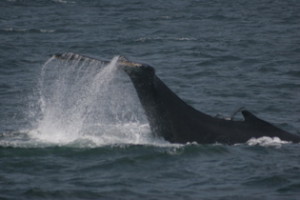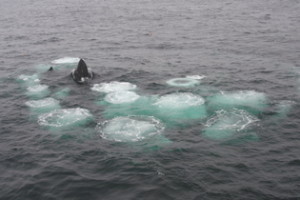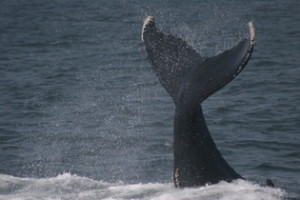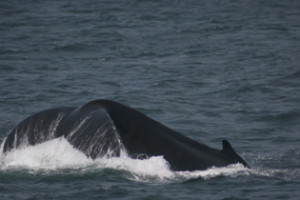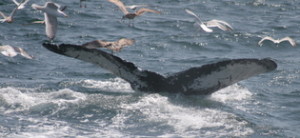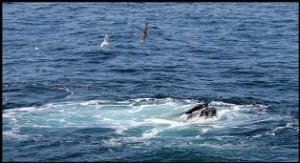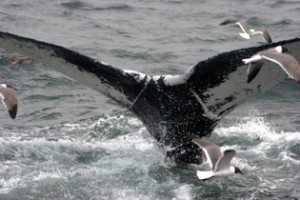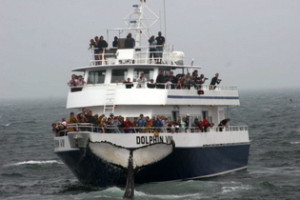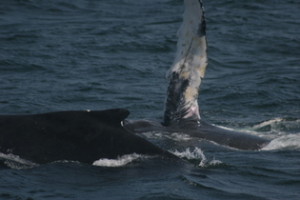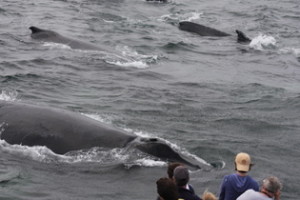DOLPHIN FLEET NATURALIST NOTEBOOK JULY 25TH-JULY 31ST
On July 25th we sailed out to the Coastguard Station and Peaked Hill with perfect sea and weather conditions—bright skies, light wind and calm seas. We observed over 19 humpbacks and 2 finbacks and identified various individuals including Apex, Canopy 2008 calf, Giraffe, Dome, Entropy, Loon, Nuages, Samovar, Ursa, Ventisca, Wyoming, Anvil & calf and Fern & calf. In the morning the Dolphin VI observed a resting humpback whale. Because humpbacks have to consciously decide to come to the surface to breath they can’t actually sleep as they would likely drown. Instead of sleeping, it is thought that humpbacks shut off half their brain; the active half reminds the whale to surface to breathe. Often when whales are resting like this they resemble logs, which is why this behavior is commonly referred to as logging. Towards the end of the Dolphin VI’s trip they observed a breaching humpback towards the end of the trip. In the early afternoon it appeared as though the whales were sub-surface feeding as many of the whales were going on fluking dives and were surfacing in the same general area. Sporadic active behaviors were observed by the Portuguese Princess, such as spinning breaches, lobtailing and close boat approaches.
Lobtailing
We left Provincetown Harbor on July 26th with grey skies, moderate wind and seas. Peaked Hill remained a humpback hotspot as we observed 16 humpbacks and 4 finbacks. We identified several humpbacks including Banyon, Giraffe, Habenero, Meteor Seal, Sirius, Snare, Venom and Skateboard and calf. We observed several feed shows throughout the day. The Portuguese Princess observed several humpbacks that were creating bubble nets to catch their prey. The Dolphin VI, however, saw humpbacks that were employing different feeding strategies such as kick feeding. Perhaps the most dynamic feeding behavior was conducted by the finbacks that were lunge feeding. The finbacks would circle around their prey and then turn onto their side and lunge out of the water with open mouths. While the whales lunged the sand lance attempted to fly to freedom as they leaped out of the water in hopes of avoiding predation. In the late afternoon the whales switched gears, as the Dolphin VI observed a myriad of active behaviors including lobtailling, tail breaching, spin breaching, and flipper slapping.
Bubble Net
July 27th was great day for whale watching with bright skies, moderate wind and seas. We had excellent whale sightings with 37 humpback whales and 6 finback whales. Several of the observed humpbacks were well known individuals such as Alpha, Ampersand, Barb, Binary, Giraffe, Ember, Dome, Draco, Entropy, Infinity, Level, Lichen, Loon, Mars, Meteor, Mostaza, Pox, Scylla, Tectonic, Thread, Tunguska, Underline, Ventisca, Walrus, Whirligig, Wizard, Apex and calf, Bat and calf, Glo and calf, Pisces and calf. For the majority of the morning and early afternoon the whales put on an incredible feed show. The Dolphin VI and the Portuguese Princess observed several humpbacks that were kick feeding and surfacing with open mouths right next to the boat. There were a few groups of humpbacks that were feeding cooperatively, as they would surface through the same bubble net together with wide-open mouths. Some of the bubble nets were almost a hundred feet across! As the whales fed, we were able to see the whale’s expanded throat grooves and their hundreds of plates of baleen. In the afternoon the Dolphin VI observed active behaviors such as lobtailing and tail breaching from Pox. Meanwhile, the Portuguese Princess was watching Mars go on spinning breaches.
Mars
July 28th was another great day to be on the water with bright skies, light wind and calm seas. We observed over 15 humpbacks and 6 finbacks and identified several whales including Banyon, Echo, Flounder, Parens, Plateau, Scylla’s 2008 calf, Sirius, Snare, Tectonic and Tulip & calf. The Portuguese Princess and Dolphin VI observed a myriad of feeding behaviors throughout the day. In the morning the whales had found a dense school of sand lance at the surface and put on a spectacular feed show with surface lunges, bubble nets and bubble clouds. While watching the humpbacks release a series of bubbles, the clouds of green fizz made thousands of sand lance visible at the surface. Some scientists believe that these bubble clouds elicit an anti-predator response whereby the fish will aggregate tightly together to avoid predation. Additionally, it is thought that the air bubbles may conceal the whale’s advance, thereby limiting the fishes ability to escape predation. In the afternoon, many active behaviors were observed such as lobtailing, flipper slapping and close boat approaching.
Bubble Cloud
We sailed out to Peaked Hill on July 29th with ideal whale watching conditions, bright skies, moderate wind and calm seas. Our whale sightings were exceptional, yet again with 39 humpbacks and 1 minke whale. We identified Backgammon, Banyon, Cosmos, Circuit, Crown, Ember, Eruption, Flock, Flounder, Lichen, Lupine, Mars, Mostaza, Peninsula, Perseid, Pivot, Samovar, Tear, Tunguska, Venom, Vulture, Walrus and Bolide & calf. In the morning the Dolphin VI and the Portuguese Princess observed a diversity of behaviors including (spin and chin) breaching, flipper slapping, lobtailing, kick feeding and surface lunging. Remarkably, both the feeding and active behaviors continued into the afternoon as Walrus and Crown were seen surface feeding with open mouths and Lichen was seen flipper slapping and lobtailing.
Crown
Tunguska
The whales continued to aggregate near Peaked Hill on July 30th. Our sea and weather conditions were optimal with bright skies, moderate wind and calm seas. Such favorable conditions made whale spotting easy with over 23 individual humpbacks observed. We identified several of the humpbacks from the day before such as Banyon, Cajun, Crown, Division, Flounder, Fracture, I-VEE, Lichen, Mostaza, Thread, Walrus, Whisk and Tulip & calf. It is likely that the whales remained near Peaked Hill because large concentrates of sand lance persisted. Over the course of the morning dozens of humpbacks were seen surface feeding with bubble clouds, and open mouths. In the early afternoon, the whales employed different surface feeding strategies such as kick feeding. While most of the observed humpbacks continued to feed, some opted for active behaviors such as flipper slapping and logging.
Flipper Slapping
On July 31 we headed for Peaked Hill and Highland Light with grey skies, light wind and calm seas. Perhaps unsurprisingly, our whale sightings remained good with over 24 humpbacks and 5 finbacks. Although several whales from previous days remained near Peaked Hill, we did observed a few new individuals such as Canopy’s 2008 calf, Jabiru, Mayo and Seal. The Dolphin VI did observe sporadic feeding, however, it seemed as though the dense schools of sand lance were no longer concentrated at the surface. Dome was kick and open mouth feeding off Highland Light and Seal became curious of the boat giving the Dolphin VI a close boat approach. Other active behaviors such as flipper slapping and breaching were observed. In the early afternoon the Portuguese Princess observed 11 humpback whales just east of Race Point. Many of the humpbacks appeared to be foraging as they were traveling randomly. Some had found schools of fish near the surface and were making bubble clouds to corral their prey and then using kick feeds to stun the already concentrated school. While near Peaked Hill the Dolphin VI observed an assortment of active behaviors including lobtailing, breaching, flipper slapping and tail breaching.
Close Boat Approach






